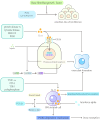Roles of IL-11 in the regulation of bone metabolism
- PMID: 38352248
- PMCID: PMC10862480
- DOI: 10.3389/fendo.2023.1290130
Roles of IL-11 in the regulation of bone metabolism
Abstract
Bone metabolism is the basis for maintaining the normal physiological state of bone, and imbalance of bone metabolism can lead to a series of metabolic bone diseases. As a member of the IL-6 family, IL-11 acts primarily through the classical signaling pathway IL-11/Receptors, IL-11 (IL-11R)/Glycoprotein 130 (gp130). The regulatory role of IL-11 in bone metabolism has been found earlier, but mainly focuses on the effects on osteogenesis and osteoclasis. In recent years, more studies have focused on IL-11's roles and related mechanisms in different bone metabolism activities. IL-11 regulates osteoblasts, osteoclasts, BM stromal cells, adipose tissue-derived mesenchymal stem cells, and chondrocytes. It's involved in bone homeostasis, including osteogenesis, osteolysis, bone marrow (BM) hematopoiesis, BM adipogenesis, and bone metastasis. This review exams IL-11's role in pathology and bone tissue, the cytokines and pathways that regulate IL-11 expression, and the feedback regulations of these pathways.
Keywords: IL-11; bone; immunity; metabolism; systematic review.
Copyright © 2024 Han, Gao, Gan, Liu, Bao and He.
Conflict of interest statement
The authors declare that the research was conducted in the absence of any commercial or financial relationships that could be construed as a potential conflict of interest.
Figures



Similar articles
-
The Emerging Role of Interleukin-(IL)-11/IL-11R in Bone Metabolism and Homeostasis: From Cytokine to Osteokine.Aging Dis. 2023 Dec 1;14(6):2113-2126. doi: 10.14336/AD.2023.0306. Aging Dis. 2023. PMID: 37199584 Free PMC article. Review.
-
Glycoprotein130 (Gp130)/interleukin-6 (IL-6) signalling in osteoclasts promotes bone formation in periosteal and trabecular bone.Bone. 2015 Dec;81:343-351. doi: 10.1016/j.bone.2015.08.005. Epub 2015 Aug 7. Bone. 2015. PMID: 26255596
-
The cytokine interleukin-11 crucially links bone formation, remodeling and resorption.Cytokine Growth Factor Rev. 2021 Aug;60:18-27. doi: 10.1016/j.cytogfr.2021.04.002. Epub 2021 Apr 24. Cytokine Growth Factor Rev. 2021. PMID: 33940443 Review.
-
IL-1 plays an important role in the bone metabolism under physiological conditions.Int Immunol. 2010 Oct;22(10):805-16. doi: 10.1093/intimm/dxq431. Epub 2010 Aug 2. Int Immunol. 2010. PMID: 20679512
-
Interleukin-6/interleukin-6 receptor complex promotes osteogenic differentiation of bone marrow-derived mesenchymal stem cells.Stem Cell Res Ther. 2018 Jan 22;9(1):13. doi: 10.1186/s13287-017-0766-0. Stem Cell Res Ther. 2018. PMID: 29357923 Free PMC article.
Cited by
-
Interleukin-19 in Bone Marrow Contributes to Bone Loss Via Suppressing Osteogenic Differentiation Potential of BMSCs in Old Mice.Stem Cell Rev Rep. 2024 Jul;20(5):1311-1324. doi: 10.1007/s12015-024-10709-3. Epub 2024 Mar 19. Stem Cell Rev Rep. 2024. PMID: 38502291
-
Unravelling the link between chronic inflammation and primary hyperparathyroidism: a systematic review.Front Immunol. 2025 Jun 2;16:1563967. doi: 10.3389/fimmu.2025.1563967. eCollection 2025. Front Immunol. 2025. PMID: 40529359 Free PMC article.
-
High-intensity ethanol binge drinking accentuates bone damage in induced apical periodontitis in rats.Heliyon. 2024 Nov 6;10(22):e40163. doi: 10.1016/j.heliyon.2024.e40163. eCollection 2024 Nov 30. Heliyon. 2024. PMID: 39641066 Free PMC article.
-
Subgingival microbiota and genetic factors (A-2570G, A896G, and C1196T TLR4 polymorphisms) as periodontal disease determinants.Front Dent Med. 2025 Jun 9;6:1576429. doi: 10.3389/fdmed.2025.1576429. eCollection 2025. Front Dent Med. 2025. PMID: 40552316 Free PMC article.
-
Activating PIK3CA mutations in adipose-derived stem cells drive mutant-like phenotypes of wild-type cells in macrodactyly.Cell Death Dis. 2025 Jul 1;16(1):477. doi: 10.1038/s41419-025-07795-7. Cell Death Dis. 2025. PMID: 40595500 Free PMC article.
References
Publication types
MeSH terms
Substances
LinkOut - more resources
Full Text Sources
Research Materials

